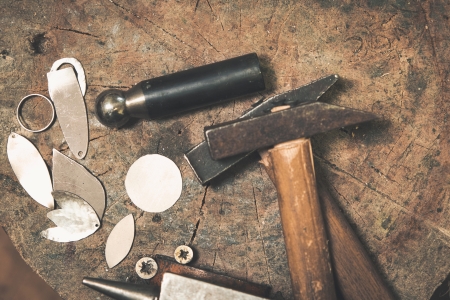New to jewellery making?
There are a whole host of jewellery making tools out there that you may not have heard of yet, and jeweller’s hammers (or ‘jewellery hammers’) will certainly take centre stage on that list. With the sheer number of jeweller’s hammers available for professional use, it can be quite a task to remember what they’re called, let alone how to use a hammer effectively! So whatever jewellery making skill you’re trying to master, using specially made jeweller’s hammers will undoubtedly play some part in the process.
That’s why we’ve put together an illustrated guide to jewellery hammers types for beginners – including information on chasing hammers, forming hammers and other metal working hammers – helping you identify the best jewellery hammer to use depending on the project.

Click here to learn more about our top 5 types of hammers for jewellery making beginners.
Basic jeweller’s hammers types
Ball pein hammer
This is one of the first jewellery hammers you should invest in as a beginner. It’s a great all-rounder, used for multiple tasks such as texturing metal, hammering doming punches and is also used as a forming hammer to shape sheet metal. Shop ball pein hammers here.

Rawhide mallet
Great for forming or resizing rings, these types of hammer won’t scratch or mark the metal you’re working with, while still providing accurate results. Shop rawhide mallets here.

Stamping hammer
Sometimes known as a ‘brass hammer’, this kind of jewellery hammer is used with stamps or metal punches on metal stamping blanks to make a creative imprint on the metal you’re using. It’s important to use a soft brass mallet when using steel stamps so that you don’t destroy the stamp under the weight of a heavy steel hammer. Shop stamping tools here.

Intermediate jeweller’s hammers types
Texturing hammer
Texturing hammers are used to dent the surface of the metal you’re working with. Instead of a high shine finish, you can instead add a texturised finish to a set of earrings or a pendant for a unique, weathered look. Shop texturing hammers here.

Chasing hammer
A chasing hammer looks a little different from your usual hammer and is sometimes referred to as a ‘repousse hammer’. The handle is built in a specific way – with a thin handle that migrates down to a thicker end, the handle is meant to give you balance. That way, when you hammer with some force you can balance it and strike down without causing it to tilt or slip. The chasing hammer also features a slightly domed face and a ball pein on the other side. This means that your chasing hammer can be used to form metal into complex relief designs. Shop repousse hammers here.

Advanced jewellery hammers types
Planishing hammer
Planishing metal refers to the flattening of sheet metal – in this case, using a planishing hammer. You’ll often see these techniques used in the forming of larger car body parts to finish the metal with a smooth surface. Even after you’ve formed a nicely curved piece of metal for your jewellery projects, it’s good to finish this work off with a planishing hammer to ensure a smooth, professional finish. Shop planishing hammers here.

Riveting hammer
The riveting hammer has one flat round face and one wedge-shaped end and is primarily used for riveting as well as creating bark like textures on sheet metal. Shop riveting hammers here.

Raising hammer
Raising metal working hammers feature a cross pein instead of a ball pein – which allows you to compress the metal, creating a convex shape without stretching it out too much. When used with a stake, you can use a raising hammer to successfully form larger pieces of sheet metal into bangles, cuffs or more complex pendants. Shop raising hammers here.

Embossing hammer
Never heard of embossing? Embossing is the stretching of metal with the use of metal working hammers. A typical embossing hammer features two ball peins of different sizes at each end. Each end can be used to add dramatic textures to your metalwork, helping you create a collection of jewellery pieces with a unique finish. Shop embossing hammers here.

Now you’ve got to grips with the basics of using hammers for jewellery making projects, discover which hammers to invest in with our top 5 jewellery hammer picks for beginners.
Want to get started right away? Pick up all the jewellery hammers or jeweller’s hammer sets you need at Cooksongold.

Cooksongold

